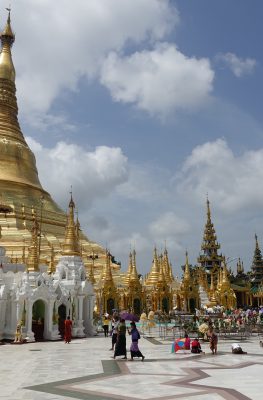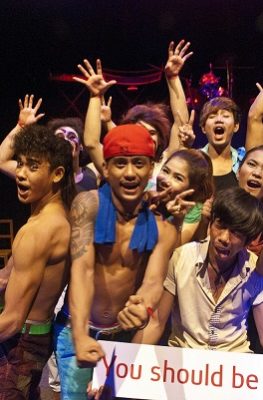Published on January 18, 2018
Prambanan Rayamana performance. Image courtesy of Mike Aquino
The patchwork of cultures existing within Southeast Asia have created a rich tapestry of cultural performances, all inspired by local religions, legends and traditions.
These performing arts draw travelers into the local imagination like nothing else can: no book can convey the fantastic vision of Indonesia’s Barong, and no photograph can immerse visitors in the rhythmic fun of the tinikling dance!
We asked several travelers to reveal their favorite cultural performances from Southeast Asia, and every experience they shared was a gem.
Kinnari-Kinnara dance in Myanmar. Image courtesy of Quirky Wanderer
Myanmar’s Fantastic Kinnari Dance
Quirky Wanderer‘s Divyakshi Gupta, for starters, found herself in the middle of a Myanmar Shan State performance that was one for the books.
“The sounds of cymbal welcomed me as I entered Myanmar Treasure resort in Inle Lake. It was twilight, and the atmosphere was electrifying.
“Two figures appeared out of nowhere in glittering costumes. I was already in love with the people of Shan state in Myanmar: their hospitality, their warmth, the colours in their attire. But here was another aspect about the Shan culture that enthralled me: The Kinnari Kinnara dance of the Shan state!
“This mythical bird couple dance is a traditional dance performed by the Shan people to celebrate celestial love between the Kinnara (male) and the Kinnari (female). In Southeast Asian Mythology, Kinnaris are depicted as half bird, half woman creatures known for their song, dance and poetry.
“The two figures on the stage resembled birds and had massive wings attached. The dancers began their performance on the beats of drums and cymbals – their dance went on for an hour, depicting various tales and fables. Truly one of the most unique dance performances I have ever seen.”
The Philippines’ Charming Tinikling Dance
Christine Rogador of the Travelling Pinoys went deep into the Philippine countryside – on the Loboc River of the island of Bohol – and rediscovered a Filipino dance she’d only seen before on television.
“Tinikling is a traditional dance in the Philippines,” she tells us. “It involves two dancers (or more) dancing in a beat of rondalla music while stepping over and in between two bamboos poles handle by two people.
“The people who handle the bamboo poles tap and slide the poles in coordination with the music. This Philippine folk dance is probably the most popular among traditional dances in the Philippines. It is also said to be one of the oldest folk dances originating as far as Spanish colonial era.
“The Loboc River floating restaurant treats visitors, not only to a sumptuous buffet lunch, but also to the traditional and amazing performances from local talents. This is where my parents and I saw the kids dancing in Tinikling with enthusiasm that can light up the serene Loboc river.
“The way the kids had fun with this dance and the way they took pride in it – a dance that goes beyond cultural identity and time – is a sight to behold.”
Ramayana dance in front of Prambanan, Indonesia. Image courtesy of My Travel Recitals
Indonesia’s Hindu-Inspired Performances
The Hindu kingdoms that once ruled Indonesia’s most populated islands have left an indelible mark on the cultural fabric. Despite most Indonesians’ professing adherence to Islam, ancient dancing forms still recall Hindu legends like the Ramayana; in Bali (the last remaining Hindu-majority island), the barong dance evokes present cultural practices among the Balinese.
Saakshi of My Travel Recitalsvisited Yogyakarta, where the age-old Ramayana epic plays out after dark with Prambanan Temple’s towers as a stark backdrop.
“More than 200 artists dressed in most fancy costumes come to enact their roles from the epic,” Saakshi tells us. “The stage is placed right in front of the temple which makes the entire show otherworldly.
“The characters are so immersed in their roles that is bound to give goosebumps to spectators. The music played adds to the charm of the drama making it almost real and closest to the ancient times. Various snippets from the epic are enacted on different days. This cultural extravaganza is a must-watch experience in the cultural capital of Indonesia.”
Barong Dance in Bali, Indonesia. Image courtesy of Lemonicks
Lemonicks’ Nisha Jha watched a different Hindu-inspired performance on the island of Bali – “a story-telling Balinese dance, narrating the fight between good and evil,” the Barong Dance.
The Barong, Nisha says, “has two main characters: Rangda, the witch, and the beast Barong. Barong refers to a guardian angel in an animal form struggling against Rangda. He is often represented as a lion with red head, white thick fur and wearing jewelry. He is accompanied by two monkeys.
“Before the dance starts, a priest offers blessings by sprinkling holy water taken from Mount Agung on the masks of Barong and Rangda which are considered sacred items.
“The story goes that Rangda was condemned by her husband because she practiced black magic. After she becomes widow, she summons all the evil spirits in the jungle.
“The dance opens with the monkeys and Barong in a peaceful environment. In the next scene while soldiers perform ‘Keris Dance’, Rangda appears and creates havoc. A fight ensues and Barong is called for help.
“Barong comes but Rangda casts a spell upon soldiers and orders them to commit suicide. They go in a trance and stab themselves with their own poisoned keris.” Nisha stops there; for travelers who want to know how it ends, “you need to see the dance drama to know how Barong saves the soldiers and the evil is defeated,” she tells us.
Cultural Performances: Honorable Mentions
In Malaysia, the Mak Yong theater performances performed only in Kelantan combines elaborate costumes with indigenous dances and music – a rare art form that predates the arrival of Islam to the country. Portraying stories sourced from Malay folk tales, the performances often last several consecutive nights, combining dancing, acting, and improvised monologues, all set to music performed by traditional Malay musicians.
Mak Yong was inscribed in 2008 by UNESCO on its Representative List of the Intangible Cultural Heritage of Humanity.
In Cambodia, Khmer classical dance has been brought back from the brink: after near-extinction in the 1970s and 1980s, dance performers returned from exile to return this art form to its rightful place in the spotlight.
Performances tend to recreate stories and legends that tell of the origins of the Khmer peoples, with four different character types and a repertoire of dance moves that can only be perfected after years of arduous training. In Siem Reap, visitors can watch truncated apsara performances that are a mere glimpse of the hours-long performances that Khmer dance was long known for.
In Singapore, a recent series of traditional arts performances has accompanied the Mid-Autumn Festival celebrations. Held by the National Arts Council at Gardens by the Bay, the cultural performances rope in traditional arts troupes from the Chinese and Indian communities, represented by various schools from all around Singapore. For more information, visit the official site.
* * * *
Read all about Divyakshi Gupta’s travel adventurers on her blog Quirky Wanderer, or visit their social media profiles on Facebook, Instagram and Twitter.
Christine Rogador blogs on the Travelling Pinoys, and publishes her social media updates on her social media profiles: Facebook, Twitter and Instagram.
Saakshi Rajat blogs at My Travel Recitals, and posts social media updates on Facebook, Instagram and Twitter.
Nisha Jha and Vasu Devan blog on Le Monde. Follow their adventures on social media: Instagram and Twitter.






